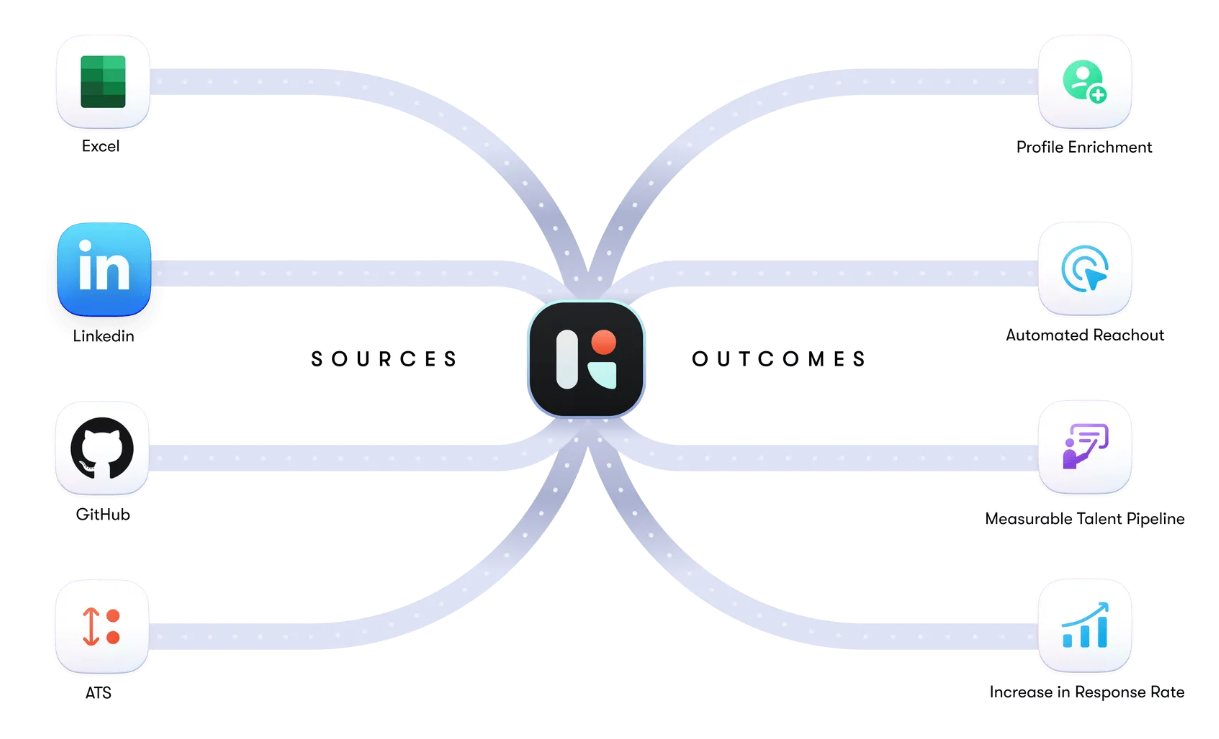ATS integrations are commonplace in SaaS. In my experience, the ATS tool has yet to be a one-stop shop for all recruitment needs. Companies use integrations to connect their ATS to CRMs, databases, or communication tools that have been used in-house for quite some time. ATS integrations allow you to connect your existing apps to new software without disrupting existing workflows and business continuity.
However, if you are new to integrations, this exhaustive article shall answer all your queries.
What are ATS integrations?
ATS integrations are apps or platforms that connect to an Applicant Tracking System, effectively extending its capabilities. Integrations help you streamline workflows, curate, consolidate and exchange candidate information, and complement your ATS contract generation, e-signing tools, etc.
Broadly, ATS integrations connect your ATS to:
- Communication platforms
- Calendars
- Job boards
- Assessment software
- Video conferencing tools
- Onboarding tools

For example, Kula integrates with candidate sources such as your spreadsheets, LinkedIn and GitHub. Upon integration, Kula captures candidates from each job portal and continuously enriches candidates without manual intervention. Kula also integrates with Microsoft Outlook, automates interview scheduling from emails, and helps you manage recruitment workflows in one centralized platform.
Examples of ATS integrations
Are you still trying to figure out what ATS integrations entail? Here are a few examples to help you visualize its features:
Job board integration
ATS integration synchronizes with popular job boards, letting you post job descriptions on multiple channels. When a candidate applies, it transfers the information to the ATS candidate repository. You can track application sources efficiently and eliminate ineffective ones.
Business communication integrations
ATS integration software offers collaboration features by syncing your internal communication platforms. You can discuss candidate profiles with teammates, add notes about their strengths and weaknesses, and share constructive feedback.
For example, Kula integrates with your Slack inbox and keeps the entire team updated on candidates’ progress through the screening process.
We have also launched a project reviews feature that centralizes all team interactions and provides clear visibility into the hiring funnel for all stakeholders.
Recruiters can track the candidate’s progress, mark candidates as “Good Fit” or “Not A Good Fit,” and add detailed feedback for context. Kula organizes all these inputs under each project and makes them accessible to everyone involved.
The result? Better decision-making and selection of the most deserving candidates.
Gmail and calendar integrations
ATS integrations also sync the recruiter’s and candidate’s Gmail and Google calendar and schedule interviews automatically based on both parties’ availability. It captures candidate interactions, allots interview slots accurately, and sends reminders.
Integrations with video conferencing tools
ATS integrations sync with video conferencing tools and record interviews. Recruiters can refer to the recordings while shortlisting candidates.
For example, Kula integrates with Zoom and records interviews automatically. The platform’s AI note-taker and interview summaries streamline feedback delivery, too. Smart chapters capture the interview gist recruiters can refer to for data-driven decision-making.
HRIS integration
ATS integration goes beyond the recruitment process and transfers the selected candidate’s information to your HRIS. From joining dates and job titles to the decided salary and benefits, the HR software records everything. This removes manual data entry and streamlines the onboarding process.
E-signature integration
Nobody wants heaps of paperwork on their first day at a new job. With e-signature integrations, you can easily share the necessary documents with candidates virtually and collect e-signatures on contracts.
What are the benefits of adding ATS integrations?
Ask any recruiter, and they’ll tout how an ATS that integrates with major CRMs, communication platforms, and job portals makes their life easier. However, if you are new to understanding the potential of ATS, let me explain:
1. Shortens up time-to-hire
It takes recruiters 44 days on average to fill an open position. However, in tight labor markets where candidates are spoilt for choice, I can assure you that you may not even have these many days to extend an offer. You inevitably lose talent to companies that have optimized their hiring cycles to be shorter.
However, you can’t rush recruitment and risk bad hires, either. Solution? Invest in an ATS that integrates with your existing tool stack to automate job postings, candidate outreach, sourcing, scheduling interviews, etc. Such automation saves time and lets your recruiters focus on candidate engagement, shortening hiring cycles, employee retention programs, etc.

For example, Kula’s integrations with job boards and one-click candidate sourcing from LinkedIn and GitHub features help you set up a multi-channel engagement flow across emails, InMails, and LinkedIn requests without requiring you to purchase and work with multiple tools.
2. Enhances candidate experience
The right integrations can even automate feedback delivery to candidates. For example, you can integrate tools like SurveyMonkey or Google Forms to gather and analyze feedback from candidates about their interview experience.
Such transparency improves the candidate experience. It also generates positive word-of-mouth and drives talent to your pipeline. Plus, not performing manual, repetitive tasks boosts the recruiting team’s job satisfaction. Integrations also simplify the application process with LinkedIn one-tap applications. Candidates don’t have to fill long-drawn forms with complicated fields. The platform captures their LinkedIn profile information and sends it to your ATS repository directly.
3. Allows faster and more accurate data collection
Collecting candidate information from different sources and entering it into your ATS is grueling. You may miss important details and lose key data points along the way. Ultimately, you will have candidate data riddled with errors, compromising the recruitment process’s accuracy.
ATS integrations ensure that only the most current data is sourced to the software. All information is beautifully organized in a centralized repository with advanced filters, offering easy access to specific candidate profiles.
For example, Kula integrates with job platforms like Linkedin and collects candidate information quickly. It also continuously enriches candidate information without manual intervention.
4. Enhances compliance and reduces risk
Recruiters deal with sensitive and private candidate information. One leak can land you into serious compliance issues and lawsuits.
ATS integrations cover candidate information and recruitment data under the software data security and compliance framework. It ensures that every hiring stage is aligned with the latest labor laws and regulations, reducing compliance and data breach risk.
For example, Kula emphasizes utmost data security with our ATS integration software. Our ATS benefits include smart data retention and automatically removing personally identifiable information according to geo-specific policies to prevent potential leaks. Candidates must permit the data usage, with their consent record fully logged for future reference. We also offer parity with built-in EEO and OFCCP reporting across sourcing channels and stages to let you intervene before escalation.
5. Offers room for scalability
As your business grows, so will your hiring workflows. ATS integration simplifies this with automation. This eliminates manual, repetitive tasks, letting your team process larger application volumes efficiently.
Since ATS integrations connect with various job boards, it creates a steady flow of candidates in your recruitment pipeline. It also monitors the web extensively and automates passive candidate sourcing. You get access to a broader talent pool, ready to be hired according to your scaling business operations.
Best practices to consider for your ATS integrations
1. Ensure compatibility with existing HR systems
You choose an ATS because it claims to integrate with HRIS. But after implementation, you realize it’s incompatible with your company’s HR system. Your investment goes down the drain, right?
That’s why testing the ATS integration software’s compatibility with your existing HR tool stack is necessary.
List the features and functionalities your existing HR solution offers. Then, screen the vendor’s integration offerings to see whether their product syncs with everything. Sign up for a free trial and examine its compatibility with your HRIS.
Does it automatically transfer data to the ATS? Is the data transfer instant, or does the system take time to synchronize?
Your ATS should also integrate with the payroll management features of HRIS. This ensures that, once you hire candidates, their details, job titles, and salary information are transferred automatically from the recruitment stage to payroll processing.
2. Implement robust data security measures
Check the data security measures of your chosen ATS integration software thoroughly. Go through their data privacy measures in the terms and conditions section and find answers to these questions:
- Do they share candidate data with third-party apps?
- Does the platform comply with local and international labor regulations and compliance like GDPR and CCPA?
Identify potential security risks and vulnerabilities associated with data transfer and storage across integrated ATS systems. Involve your IT team to examine the encryption of the ATS tool’s data storage.
You must also evaluate whether the ATS integration allows role-based access control to the data repository. This will help you contain sensitive information within the stakeholders, reducing data-leak risks.
Even after you evaluate all the above elements, run regular security audits to ensure continuous data security.
3. Regularly update and maintain the system
Update your ATS integrations regularly to let your team use every feature holistically. Ask your team whether they need upgrades or add-ons to make the system more efficient.
Seek ongoing technical support for ATS system maintenance. Don’t hesitate to contact the vendor’s tech assistance teams if necessary. Ensure your new recruitment tools sync with your ATS system. Such consistent monitoring and updates will uphold the effectiveness of ATS integration in the long run.
4. Provide comprehensive training for all users
Train your recruitment team on ATS features, integrations, and benefits. Educate them on how it reduces their workload and streamlines the hiring process. Knowing all the benefits will maximize company-wide ATS adoption. You can:
- Assign mentors to every member of your recruiting team.
- Offer detailed onboarding sessions where they get hands-on practice in using the tool.
- Give access to user manuals.
- Create internal tech stack modules with a dedicated section for ATS integrations.
Conclusion
With limited hiring needs, the importance of ATS integration may seem like a stretch. However, as your staff requirement scales, it can save precious hours and streamline your recruitment process.
Ensure your ATS integrates with job boards, email, and calendar. It must cover HRIS, video conference tools, and other communication platforms. Tools like Zapier or Workato also facilitate easy integrations in an ATS.
In short, you need software whose integration fits your existing system like a glove—and that’s what we offer with Kula.
Our platform automates your recruiting workflow with extensive integrations, from syncing job boards to scheduling interviews. You can set up automated communication emails, collaborate with teammates through Slack, and enable reminders on recruiters' calendars. We also capture Zoom interviews and generate feedback.
So what are you waiting for? Sign up for free and create your recruitment eco-system with Kula’s ATS integrations.
